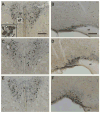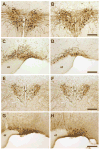A single prolonged stress paradigm produces enduring impairments in social bonding in monogamous prairie voles
- PMID: 27522019
- PMCID: PMC5226121
- DOI: 10.1016/j.bbr.2016.08.022
A single prolonged stress paradigm produces enduring impairments in social bonding in monogamous prairie voles
Abstract
Traumatic events such as natural disasters, violent crimes, tragic accidents, and war, can have devastating impacts on social relationships, including marital partnerships. We developed a single prolonged stress (SPS) paradigm, which consisted of restraint, forced swimming, and ether anesthesia, to establish an animal model relevant to post-traumatic stress disorder. We applied a SPS paradigm to a monogamous rodent, the prairie vole (Microtus ochrogaster) in order to determine whether a traumatic event affects the establishment of pair bonds. We did not detect effects of the SPS treatment on anhedonic or anxiety-like behavior. Sham-treated male voles huddled with their partner females, following a 6day cohabitation, for a longer duration than with a novel female, indicative of a pair bond. In contrast, SPS-treated voles indiscriminately huddled with the novel and partner females. Interestingly, the impairment of pair bonding was rescued by oral administration of paroxetine, a selective serotonin reuptake inhibitor (SSRI), after the SPS treatment. Immunohistochemical analyses revealed that oxytocin immunoreactivity (IR) was significantly decreased in the supraoptic nucleus (SON), but not in the paraventricular nucleus (PVN), 7days after SPS treatment, and recovered 14days after SPS treatment. After the presentation of a partner female, oxytocin neurons labeled with Fos IR was significantly increased in SPS-treated voles compared with sham-treated voles regardless of paroxetine administration. Our results suggest that traumatic events disturb the formation of pair bond possibly through an interaction with the serotonergic system, and that SSRIs are candidates for the treatment of social problems caused by traumatic events. Further, a vole SPS model may be useful for understanding mechanisms underlying the impairment of social bonding by traumatic events.
Keywords: PTSD; Paroxetine; Partner preference; SSRI; Serotonin; Social behavior.
Copyright © 2016 Elsevier B.V. All rights reserved.
Figures






Similar articles
-
Oxytocin receptor antagonist reverses the blunting effect of pair bonding on fear learning in monogamous prairie voles.Horm Behav. 2020 Apr;120:104685. doi: 10.1016/j.yhbeh.2020.104685. Epub 2020 Jan 24. Horm Behav. 2020. PMID: 31935400 Free PMC article.
-
Increased proliferation and neuronal fate in prairie vole brain progenitor cells cultured in vitro: effects by social exposure and sexual dimorphism.Biol Sex Differ. 2023 Nov 2;14(1):77. doi: 10.1186/s13293-023-00563-2. Biol Sex Differ. 2023. PMID: 37919790 Free PMC article.
-
Breaking bonds in male prairie vole: long-term effects on emotional and social behavior, physiology, and neurochemistry.Behav Brain Res. 2014 May 15;265:22-31. doi: 10.1016/j.bbr.2014.02.016. Epub 2014 Feb 20. Behav Brain Res. 2014. PMID: 24561258 Free PMC article.
-
Neurochemical regulation of pair bonding in male prairie voles.Physiol Behav. 2004 Nov 15;83(2):319-28. doi: 10.1016/j.physbeh.2004.08.024. Physiol Behav. 2004. PMID: 15488548 Review.
-
Oxytocin, vasopressin and pair bonding: implications for autism.Philos Trans R Soc Lond B Biol Sci. 2006 Dec 29;361(1476):2187-98. doi: 10.1098/rstb.2006.1939. Philos Trans R Soc Lond B Biol Sci. 2006. PMID: 17118932 Free PMC article. Review.
Cited by
-
The Oxytocin-Vasopressin Pathway in the Context of Love and Fear.Front Endocrinol (Lausanne). 2017 Dec 22;8:356. doi: 10.3389/fendo.2017.00356. eCollection 2017. Front Endocrinol (Lausanne). 2017. PMID: 29312146 Free PMC article. Review.
-
Gait and Conditioned Fear Impairments in a Mouse Model of Comorbid TBI and PTSD.Behav Neurol. 2018 Sep 20;2018:6037015. doi: 10.1155/2018/6037015. eCollection 2018. Behav Neurol. 2018. PMID: 30327687 Free PMC article.
-
Extended amygdala corticotropin-releasing hormone neurons regulate sexually dimorphic changes in pair bond formation following social defeat in prairie voles (Microtus ochrogaster).bioRxiv [Preprint]. 2024 Nov 12:2024.11.11.623026. doi: 10.1101/2024.11.11.623026. bioRxiv. 2024. Update in: Neuropsychopharmacology. 2025 May;50(6):965-975. doi: 10.1038/s41386-025-02067-6. PMID: 39605377 Free PMC article. Updated. Preprint.
-
Systematic Review and Methodological Considerations for the Use of Single Prolonged Stress and Fear Extinction Retention in Rodents.Front Behav Neurosci. 2021 May 14;15:652636. doi: 10.3389/fnbeh.2021.652636. eCollection 2021. Front Behav Neurosci. 2021. PMID: 34054443 Free PMC article.
-
Effects of oxytocin on prosocial behavior and the associated profiles of oxytocinergic and corticotropin-releasing hormone receptors in a rodent model of posttraumatic stress disorder.J Biomed Sci. 2019 Mar 21;26(1):26. doi: 10.1186/s12929-019-0514-0. J Biomed Sci. 2019. PMID: 30898126 Free PMC article.
References
-
- Collimore KC, Carleton RN, Hofmann SG, Asmundson GJG. Posttraumatic stress and social anxiety: the interaction of traumatic events and interpersonal fears. Depress Anxiety. 2010;27:1017–1026. - PubMed
-
- McMillan KA, Sareen J, Asmundson GJG. Social anxiety disorder is associated with PTSD symptom presentation: an exploratory study within a nationally representative sample. J Trauma Stress. 2014;27:602–609. - PubMed
-
- Bosch OJ, Dabrowska J, Modi ME, Johnson ZV, Keebaugh AC, Barrett CE, Ahern TH, Guo J, Grinevich V, Rainnie DG, Neumann ID, Young LJ. Oxytocin in the nucleus accumbens shell reverses CRFR2-evoked passive stress-coping after partner loss in monogamous male prairie voles. Psychoneuroendocrinology. 2016;64:66–78. - PMC - PubMed
-
- Kazan D, Calear AL, Batterham PJ. The impact of intimate partner relationship on suicidal thoughts and behaviors: a systemic review. J Affect Disord. 2016;190:585–598. - PubMed
Publication types
MeSH terms
Substances
Grants and funding
LinkOut - more resources
Full Text Sources
Other Literature Sources
Medical
Research Materials

